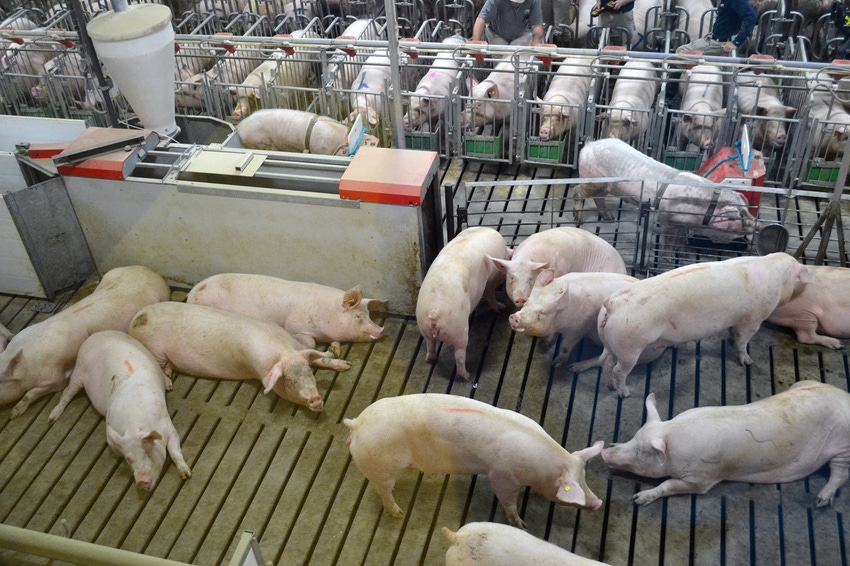Proper age and weight at first heat are critical to getting a gilt off to the right start – and for productivity of future parities.
January 14, 2019

By James Lehman, Merck Animal Health
The key to a well-run sow farm is strategically leveraging all possible tools to meet production targets — including the gilt pool. Nearly one-quarter of all litters farrowed within commercial herds come from gilt litters — a significant contribution to animal flow. Yet, even top-performing operations can struggle from time to time with the gilt pool. As you prepare gilts for the breeding herd, there are three ways to maximize potential and longevity.
Weight and age at first heat are key indicators of breeding potential
Proper age and weight at first heat are critical to getting a gilt off to the right start — and for productivity of future parities. Gilts that are too heavy when bred are at risk for decreased longevity in the herd. Check with your genetics supplier for specific recommendations, but the following weight and age targets are applicable to most modern commercial females.
At final selection, gilts should be in the 225-275 pound range and at about 22-26 weeks of age. Most lines can respond to boar exposure to stimulate heat at this time.
Breed on the second or third heat cycle when the gilt is 32-34 weeks of age and weighs between 300 and 325 pounds.
Following these age and weight targets should result in most gilts farrowing at a weight of about 400 pounds. This weight is optimal for lactation potential, decreased lifetime feed maintenance needs and overall longevity compared to gilts that are larger (450 pounds and heavier) at the time of first farrowing.
Breeding at the optimal age and weight is sometimes easier said than done, especially during seasonal infertility months when challenges include increased age at first heat and complete failure to show heat in some gilts. Farm staff must be watching more closely during these times so heat cycles are not missed.
When on ad lib feed, gilts may gain up to 20 pounds (sometimes more) weekly, so delays in cycling or missed heat detection often result in gilts that are overweight at mating time. The combination of growth rate and delayed estrus can lead to overweight gilts at mating, too. Most farms do not weigh gilts with scales, but flank-to-flank measurements or girth tapes can be used to accurately estimate weights.
Have plenty of boar power to stimulate gilts
Make sure your staff is properly trained to heat check and that they understand the importance of the boar. If you are having trouble meeting gilt breeding targets, review heat-no-service data frequently so you can be aware of gilt cycling problems before things get out of hand. Be sure you have adequate boar power of the correct size and maturity. Immature boars do not stimulate heat as well as mature boars, and a boar with a strong libido will propel gilts into puberty more quickly.
Have three to five heat check boars per 1,000 females and regularly circulate new boars into your program to maintain an annual replacement rate of 40 to 60%. Many herds use Meishan crossbred boars to heat check. If you are producing heat check boars internally, having a standing quarterly order for enough Meishan semen to farrow 1-2 sows per quarter should ensure adequate boar power. If you are purchasing boars, standing orders will also prevent emergency ordering. Purchased boars often need several weeks or months to mature after arrival.
Be ready to increase the gilt pool before next summer
If your operation struggles with seasonal infertility, make plans this winter to increase the gilt pool size. Consider renovating pens to accommodate additional gilts during the summer months. Simply adding more gilts to the same pen space may actually cause additional problems. Gilts need adequate space, ideally 12-15 square feet per head. Overcrowding will make heat stimulation and detection more difficult. Give your genetic supplier plenty of notice of your gilt needs so they can ensure supply.
Your staff must also know the difference between heat checking gilts versus sows. Gilts often require more time and attention to stimulate their first heat. Added patience is required in the gilt developer compared to heat checking weaned sows, especially in the hot months.
Summer vacation schedules can create staffing challenges. There should be properly trained team members available to heat check and care for the gilt pool at all times. If there are staffing shortages, synchronizing gilts with altrenogest can help effectively manage gilt breeding. Altrenogest is not a substitute for heat stimulation and detection; however, it allows heat synchronization, so gilts can be bred when it’s convenient and efficient. This technology is especially effective on gilts that have had at least one estrous cycle.
The gilt pool has a critical role to play in your breeding herd, but their full potential can’t be unleashed without proper planning and consideration. Reach out for help if gilts are not cycling as expected. Do not hesitate to contact your vet, nutritionist or other trusted expert to determine what interventions are needed to achieve maximum breeding herd success.
For a more detailed explanation on gilt management and other reproductive considerations, click here to view a National Hog Farmer webinar sponsored by Merck Animal Health.
Source: Merck Animal Health, which is solely responsible for the information provided, and wholly owns the information. Informa Business Media and all its subsidiaries are not responsible for any of the content contained in this information asset.
You May Also Like



